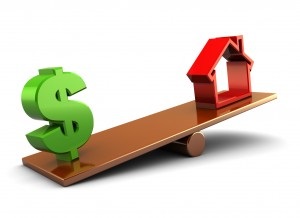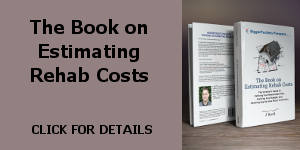
While many of my readers flip houses for a living, I hear time and again how they plan to transition into holding rentals at some point as well (and some already do). Not to mention, I’m starting to focus a bit more on long-term buy-and-hold projects also. With that in mind, I wanted to talk a bit about an important buy-and-hold topic — leverage — why it’s good (and bad) and when you might want to consider it for your rental projects.
Let’s start with…
What is Leverage?
In a nutshell, leverage is borrowing or making use of other people’s money to (hopefully) increase the returns you get on your investments. A loan is the most common form of leverage in real estate — you use some of your own money (your down-payment) to buy a property and you borrow money for the rest of the cost. Depending on various things, borrowing some or all of the money for the purchase may increase (or decrease) the ROI of the investment.
Here’s an example:
Let’s say you buy a property for $100,000 and you spend all your own cash to acquire it (no loan). Let’s also say that the property generates $1,200 per month in rent, with half of it going to expenses. At the end of every month, you earn an average of $600 in cash flow (profit); this translates to $7,200 per year in cash flow (profit). A simple ROI calculation of dividing the profit into the investment amount ($7,200 / $100,000) tells us that our ROI on this property is 7.2%.
Now, what if we bought the same property with a typical loan, where we put down 20% ($20,000) and borrowed 80% ($80,000) for 30 years at 4% interest. Plug the info into a mortgage calculator and you’ll see that our monthly payment would be $405. Going back to our numbers above, we’d now have to subtract the $405 per month in mortgage from the $600 you were earning, leaving you with $195 per month in cash flow (profit). That equates to $2,340 per year in cash flow (profit).
As you can see, our annual profit has decreased a good bit, but so has our total investment into the deal — from $100,000 of our own money to just $20,000. Our ROI now looks like this: $2,340 / $20,000 = 11.7%. We’ve increased our ROI from 7.2% to 11.7% just by borrowing money!
Positive Leverage vs. Negative Leverage
In the example above, because the borrowed money (the leverage) has increased our ROI on the property, we call it “positive leverage.”
Now, what if we have the same scenario as above, but instead of borrowing the $80,000 at 4.5% interest for 30 years, we instead have to pay 7% interest on the money? Plugging the numbers into our mortgage calculator again, we get a monthly mortgage payment of $532. Using the same example as our original, we subtract the $532 in mortgage from the $600 per month we were earning, and we see that in this scenario, our cash flow (profit) drops to $68 per month, or $816 per year.
As expected with the higher interest rate mortgage, our annual profit has dropped even more. And if we run our ROI calculation — dividing our $816 profit into our $20,000 investment, we determine that our ROI has dropped to 4.1%. In this case, borrowing money has decreased our ROI — when that happens, we call that, “negative leverage.”
Real estate is wonderful in that it’s one of the few types of investments where you can actually use leverage; but by the same token, improper use of leverage can be very risky for real estate investors. The first risk is mentioned above — finding yourself in a negative leverage situation — but there are other risks as well…
Leverage Risks
In addition to negative leverage, there are three big risks when using leverage:
- Leverage generally adds additional costs to your investment each month — the mortgage payment. When you purchase for all cash (no loan), if a tenant moves out the house is vacant, the monthly cost to keep the property is relatively low — taxes (which are typically not paid each month), insurance (also not paid each month) and perhaps utilities. If it takes three months to get a new tenant into the property, the out-of-pocket costs won’t be fun, but they likely won’t bankrupt you. On the other hand, if you have a $400 or $500 mortgage payment each month — like in the examples above — that adds significant out-of-pocket costs when a unit is empty…or worse yet, when you have a tenant who isn’t paying and you’re going through an eviction. Having cash reserves can mitigate this situation, of course, but it’s still not fun.
- Leverage can destroy liquidity. Here’s what I mean by that: Imagine a situation where you need some quick cash. For example, you have an emergency expense, your child is about to go to college, you have medical bills, you need a new car, etc. And let’s say that you own a house and want to sell the house to get that cash. If you paid all cash for a property, you could sell it regardless of whether the market has increased, decreased or stayed the same since your purchase. You might have to take a loss, but you can still sell. Now, imagine you had a loan on the property for 80% of the value, and imagine that the market value has dropped 30% since your purchase (this happened in many places back in 2007-2008) — you now owe more on the loan than you can sell the house for! If you don’t have extra cash sitting around to pay the difference between what you owe and what you can sell the house for, you can’t sell the house.
- Leverage can cause bankruptcy. There are several different types of loans — fully amortizing vs. balloon and fixed-rate vs. adjustable rate are a couple big differentiators. A fully amortizing loan is one where, at the end of your payments, you owe nothing more to the lender and the house is yours, free and clear; a balloon loan is one where, at some time in the future, your have agreed to pay off the loan with a large lump sum. A fixed rate loan is one where the interest rate stays the same throughout the life of the loan; an adjustable rate loan is one where the interest rate may change (up or down) at some point(s) in the future. If you have a fully-amortizing fixed-rate loan (one where the interest rate stays the same for the life of the loan and then you own the house), there is little risk — you know how much you’ll owe every month until the day the house is paid off. But, if you have a balloon loan and/or an adjustable rate loan, there will come a time in the future when you’ll either owe a big chunk of cash (balloon payment) or your interest rate may increase, making your monthly mortgage payment higher. In either/both of these situations, if you’re not prepared, you may find yourself in financial trouble. If the market has gone up, you always have the option to sell the house and get out of the loan; but if the value of the house has decreased to the point where you owe more than the house is worth, you could find yourself facing foreclosure…or worse yet, bankruptcy.
Now that you know the benefits and risks of leverage, it’s probably worth spending a few minutes discussing to what extent leverage can actually help you increase your returns — knowing how much leverage can (and can’t) help you will go a long way towards determining when — and how — leverage you should use.
The Value of Leverage
The value of leverage can best be demonstrated using a graph that depicts when and by how much ROI increases as leverage increases. In order to build that graph, we need an example property to work with. I’m going to assume a rental property that generates 2% of its cost in monthly rent and where all costs (expenses + rent loss + capex) are 50% of that gross income. For example, a $100,000 property with $2,000 per month in rent that generates $1,000 in cash flow after all costs.
For an all cash purchase we can figure out the return pretty easily — the property generates 2% of the purchase price in rent per month, but half goes to all the costs. That leaves 1% of the purchase price per month in profit. Multiply by 12 months, and that’s 12% of the purchase price per year in profit. In our example above, that’s $12,000 in profit per year on a $100,000 property. As you can probably figure out, that’s a 12% ROI. And remember, this is with an all cash purchase.
The graph below indicates how — as leverage increases — the ROI increases. We look at the leverage impact using two common types of loans — a conventional loan (blue line) and a portfolio loan (green line) — with leverage amount indicated on the X-axis and it’s resulting ROI indicated on the Y-axis:

Here are some takeaways from this graph:
- Below 60% leverage, ROI is basically flat, without much opportunity for leverage to impact ROI, regardless of type of loan.
- Between 60-80% leverage, amortization/rate of the loan (the conventional loan has the longer amortization and lower rate) will determine whether you can start to increase your ROI or not.
- Above 80%, any positive leverage will greatly increase your ROI, but the amortization/rate will play a HUGE role in the extent of the increase.
The key takeaway is that, for lower amounts of leverage, conventional versus portfolio loans make no difference — and, in fact, leverage doesn’t make much of a difference at all. For medium amounts of leverage (60-80%), there is a big difference in CoC based on type of loan chosen. And for larger amounts of leverage, both loan choices are good, but conventional terms/rates are very beneficial.
So, now that you have most of the big pieces of the puzzle, the question is: Should you use leverage for your deals? Or should you purchase with all cash?
Should You Use Leverage
Whether or not to use leverage is a very personal question — meaning each investor needs to ask himself what his goals are, what his level of comfort is with risk, etc. Personally, I like to use leverage because it increases my returns, but I like to use leverage conservatively to avoid the big risks that go along with it’s use.
By conservatively, I mean that:
- I always ensure that I have adequate cash reserves.
- I try to keep my leverage to about 70-80% of what I paid for the property (this way, I get the benefits of leverage, but the market can drop 20-30% and I’m still “safe”.
- I try to use loans that have the longest amortization period and lowest interest rate possible.
- I try to avoid using balloon loans and adjustable rate loans, and if I do, I try to ensure I have a plan in place for when the balloon payment is due and/or if the interest rate increases.
Those are my personal views on using leverage. I know other people who never use leverage and always pay cash. I know others who will leverage up to 100% of the purchase price (putting in no money of their own, if possible). None of these strategies is inherently right or wrong; it’s just a question of what’s right or wrong for each individual investor.
Hopefully this gives you enough information to help you make informed decisions on how YOU plan to use (or not use) leverage for your real estate investments.




on your newest article about leveraging, you have an error as follows:
Going back to our numbers above, we’d now have to subtract the $195 per month in mortgage from the $600 you were earning, leaving you with $195 per month in cash flow (profit).
should be:
Going back to our numbers above, we’d now have to subtract the $405 per month in mortgage from the $600 you were earning, leaving you with $195 per month in cash flow (profit).
Thanks Tanja!
Thanks, J. Very informative and delivered in terms people can understand. I’ll just point people to this article from now on when I’m asked to explain it!
Thanks for the post J. I’m always interested to hear a real estate investor’s take on leverage. I just bought your book on estimating reno costs and am looking forward to reading it.
Very solid run down on leverage! For someone who’s new to the business, this includes a lot of good starting points, but it also has some good advice that more experienced people need to be reminded of. Thanks for sharing.
Another point that wasn’t specifically discussed is the portion of your mortgage payment that is applied to the principal balance is technically money that is going right to your net worth. Additionally, the interest portion of your mortgage payment is tax deductible. Whatever dollar value that calculates to be (based on your tax situation) is also technically coming back to you come tax time. I have 4%ish 15 yr notes on my rental properties, so a substantial portion of the monthly mortgage payment is applied to principal.
Hey Steve,
Great points. I typically don’t factor tax benefits into my analysis (they change year to year and could go away at the whim of the government), but certainly if you factor in the additional equity of the mortgage paydown, your total return is increased above your CoC return.
Do you mind me asking about your personal house?
The reason I’m asking is that I’m currently building my personal house and was debating 30-year vs 5-year ARM and pay it off early, while keeping leverage on the investment property.
Thoughts?
Hey Jimmy,
I debated the same thing. Decided I didn’t like the risk of the 5-year ARM, and decided to go with a 30 year fixed at 50% LTV. I liked that route because it let me use some leverage, but I wouldn’t have to worry about being underwater if the market dropped. Also, it also guaranteed that I’d have a low payment, so I can decide to pay it off faster if I want or just pay it out for the full amortization. Also, I have enough equity that if I ever needed the cash, I could get a HELOC. Really no science to my decision…just what seemed to “feel” right to me.
Thanks for the response.
Funny enough, that’s probably the exact route I’m going to take.
Thanks for documenting your new construction project at http://www.thescottpad.com/
It was very motivational for me!
Hello J , Thanks for this great wealth of information!!
in your scenario “Let’s also say that the property generates $1,200 per month in rent, with half of it going to expenses” could you elaborate what expenses would be incurred to take up half of your of your income/mo ? I’m thinking taxes and insurance and maybe property maintenance ( which Ill do myself) but that seems hardly half of any scenario I’m looking at. Any clarification would be greatly appreciated by this newbie. Thanks!
J, I just read the 50% rule, never mind, thanks!
Thank you J! I have really been struggling with the risk vs reward of leverage and this helps me better tackle that. I am a Dave Ramsey follower and he is so firm in his conviction to run all businesses debt free. I really struggle with that when, as you point out, there are perfectly viable risk mitigators that can be put into place. The key is setting up those rules for investing and sticking to them…..not getting excited and sucked into over leveraging.
Thank you for all you do.
Mykael,
In my opinion, Dave Ramsey is a great role model for people who either aren’t good at managing their money and/or aren’t skilled at investing. For others, I think Ramsey is way too conservative. Just my $.02…
[…] All about leverage […]
Great post J..Really informative and easily understandable. Helped to so many problems in this particular scenario.. Keep writing… waiting for more of you.
Inspiring strategy! As you describe the entire scenario of Leverage, Its really easily to understand for anyone…Thanks you so much for your help & Keep writing to educate people.
Wow, This is stunning! Great Post Thanks for sharing
Thanks for sharing this article….
This article is of course interesting and informative.
Would it be possible for me to use my house (my only one so far) as collateral in a purchase of house that I could use as rental property?
If so, how could I go about doing that?
Kevin –
You could attempt to get a HELOC against your house, or to do a fixed-term refinance.